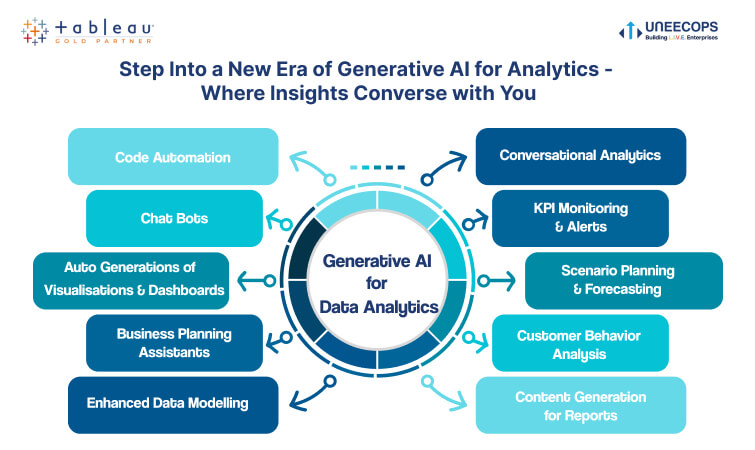The most successful businesses are the ones that constantly Learn and Adapt.
No matter what industry you’re operating in, it’s imperative to understand
What has happened in the past,
What’s going on now, and
To anticipate what might happen in the future.
So how do companies do that? The answer is Data Analytics!
But the kind of insights you get from your data depends on the type of analysis you perform.
Types of data analytics play a pivotal role in shaping business strategies. By dissecting raw data, this process has evolved into four primary categories: Descriptive, Diagnostic, Predictive, and Prescriptive Analytics, each offering a unique perspective on data interpretation.
With this write-up we aim to demystify the different types of data analytics. You as a reader will gain an understanding of how each method contributes to a comprehensive data analytics strategy, enhancing the ability to make better decisions in a business context.
Descriptive Analytics: Understanding What Happened
Descriptive analytics serves as the cornerstone of a comprehensive data analytics strategy, transforming raw data into a digestible format. Here’s how it benefits decision-making for C-suite executives:
- Simplified Data for Better Understanding
- Transforms complex datasets into understandable insights
- Utilizes data visualization tools for clear communication
- Generates business metrics, reports, and KPIs for easy consumption
- Historical Insight for Past Performances
- Provides a historical perspective to identify trends and patterns
- Enables organizations to review past performance methodically
- Highlights strengths, weaknesses, and opportunities based on historical data
- Informed Decision Making
- Identifies patterns, trends, outliers, and correlations for better strategic planning
- Lays the groundwork for predictive analytics by establishing a historical data foundation
- Provides a lens through which leaders can gain a deeper understanding for better decision making
| Success Stories Amazing Amazon’s Product Recommendations: By analyzing its past customer behavior, purchase history and browsing patterns, Amazon employs descriptive insights and offered personalized product recommendations. This helped them in enhancing customer satisfaction but also drives higher sales as customers are more likely to purchase products tailored to their preferences. Starlite Starbucks’ Store Locations: Starbucks utilized descriptive analytics to determine optimal store locations. By analyzing historical data on foot traffic, demographics, and local economic factors, Starbucks identified prime locations for new stores. This enabled them to target areas with high customer potential and avoid locations that might be less profitable. Ultimate Uber’s Surge in Pricing: Uber employed descriptive data analytics to implement surge pricing during peak demand periods. The historical ride request data, traffic patterns and event schedules, helped Uber in predicting periods of high demand and adjust the prices accordingly. This helped them in maximizing revenue during busy times while encouraging more drivers to be available, ultimately benefiting both drivers and riders. Cool Coca-Cola’s Inventory Management: Coca-Cola used descriptive analytics to optimize production and distribution processes. By analyzing historical sales data, weather patterns and promotional activities, they adjusted production levels and distribution routes. This ensured retailers to have sufficient stock during high-demand periods, minimize waste and enhance customer satisfaction. Gainful Google’s ad Targeting: Google leveraged descriptive analytics to enhance its ad targeting capabilities. The user search history, browsing behavior and demographic information, helped Google in delivering relevant ads to users, increase the likelihood of ad engagement and conversions. This approach benefited advertisers by reaching a more receptive audience and enhance the user experience by showing ads aligned with their interests. |
By leveraging these types of data analytics, stakeholders can enhance their data storytelling, making complex information accessible to various audiences without the need for advanced technical skills.
Read More: How Business Analytics Helps in Business Growth in 2024?
Diagnostic Analytics: Understanding why it happened
Diagnostic analytics is one of the types of big data analytics that delves into data to uncover the underlying causes of observed events, behaviors, and outcomes. It goes beyond the surface level data analytics strategy by variety of techniques:
- Hypothesis Testing: Formulating and testing hypotheses to validate or discount potential reasons
- Regression Analysis: Exploring relationships between variables to understand the impact on outcomes
- Anomaly Detection: Identifying data points that deviate significantly from the norm
- Root Cause Analysis: Investigating the origin of issues to prevent recurrence
- Correlation Analysis: Assessing the strength and direction of relationships between variables
- Cohort Analysis: Comparing groups over time to identify patterns
In sales and marketing, it can reveal the reasons behind changes in customer behavior or sales trends, while in IT and product development, it can help in finding the causes of system failures or user engagement drops, thereby guiding improvements. As such, it becomes an indispensable tool for C-suite executives.
Predictive Analytics: Forecast what it might happen
Predictive analytics employs statistical modeling and machine learning to formulate predictions about upcoming outcomes, serving as a crystal ball for businesses in various domains. Here’s how predictive analytics becomes one of the crucial types of data analytics:
- Trend Analysis and Forecasting: By examining current and historical data, predictive analytics identifies risks and opportunities early on
- Financial Implications: It offers tangible benefits like cost savings and revenue generation
- Strategic Applications: From setting prices to planning marketing campaigns, predictive analytics informs strategic decisions, enhancing profitability and customer satisfaction
With a market size poised to grow significantly, these types of big data analytics are a linchpin in business strategy, enabling companies to mitigate risks and reduce costs by anticipating the success or failure of products before they hit the market.
Prescriptive Analytics: Recommended action
Prescriptive analytics represents the pinnacle of data analytics strategy, offering actionable recommendations based on the insights gleaned from predictive analytics. The process of these types of data analytics involves several key steps:
- Objective Definition: Establishing clear goals to guide the analysis
- Data Consolidation: Gathering relevant data from various sources
- Model Construction: Developing algorithms and models to analyze the data
- Model Implementation: Applying the models to real-world scenarios
- Decision Execution: Making informed decisions based on the model’s recommendations
The tools utilized are diverse, ranging from programming languages like SQL and Visual Basic to sophisticated software such as H2O Driverless AI and IBM Watson Studio.
In the realm of business, these types of big data analytics find applications across multiple sectors. Investment firms leverage it for making more accurate decisions, while sales teams use it for lead scoring to prioritize potential customers. In banking, it plays a crucial role in detecting and preventing fraud. Additionally, product development teams employ prescriptive analytics to enhance their offerings and drive innovation.
Empowering C-suites with Data Analytics
Throughout this exploration of the varied types of data analytics, we have uncovered the integral roles that big data analytics play in empowering C-suite executives.
In harnessing these types of big data analytics effectively, leaders gain not only a clearer vision of past performance but also foresight into future possibilities, fortifying their decision-making with solid, data-driven grounding. As the demand for easy to understand workflows in the C-suite increases, it is clear that simplifying data narratives is key to ensuring that insights reach all levels of an organization.
As companies seek to grow from the foundational stage on up to the cognitive stage, they all need some form of advanced analytics, data strategy and data science capabilities, team or partner. Learn how Uneecops use analytics and business intelligence technologies to reimagine business capabilities. Turn Data Into Value With Data Analytics Experts at Uneecops.







